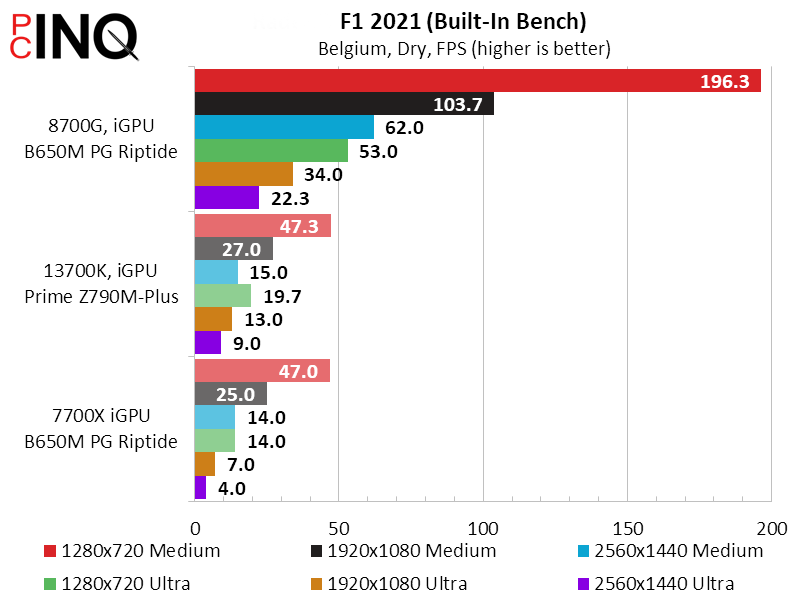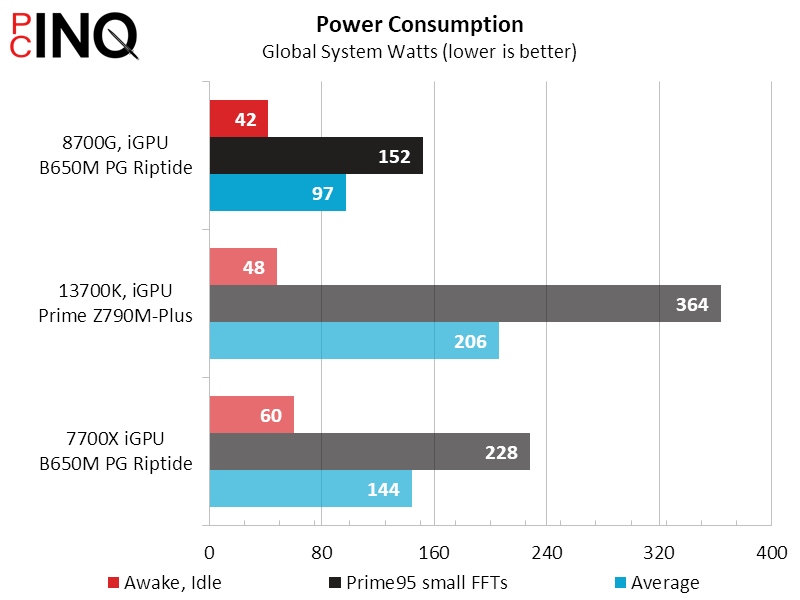Will It Game? AMD Ryzen-7 8700G Review
Graphics cards are increasingly expensive, but finding a reasonable substitute by way of integrated graphics has always been a challenge—at least for DIY builders. A decade ago Intel’s “Iris Pro” equipped Core i7-4770R processors could play the then-current F1 2012 at 1080p and high details, but that model was only available as a BGA (ball grid array, ie, soldered-down) option for motherboard manufacturers: The socketed model 4770K came with a weaker graphics solution that could only reach similar frame rates by dropping the screen resolution from 1080p to 720p. Fast forward to 2021 and AMD was restricting the sale of its 5700G to system integrators. Both manufacturers justified those moves with the idea that gamers really only want systems with graphics cards, though AMD eventually relented as the GPU shortage continued.

AMD decided to skip the drama this time and simply release its 8000 G series directly to the retail channel, complete with retail packaging and a factory cooling solution that should satisfy the stingiest of budget builders. That last part might raise the concern that its 8700G is designed for only the weakest builds: Will it game?
| AMD Ryzen™ 7 8700G | Intel Core™ i7-13700K | AMD Ryzen™ 7 7700X | |
| CPU Cores | 8 | 16 | 8 |
| Threads | 16 | 24 | 16 |
| Base Clock | 4.2 GHz | 3.4 GHz | 4.5 GHz |
| Boost Clock | Up to 5.1 GHz | Up to 5.4 GHz | Up to 5.4 GHz |
| L1 Cache | 512 KB | 1.4 MB | 512 KB |
| L2 Cache | 8 MB | 14MB | 8 MB |
| L3 Cache | 16 MB | 30MB | 32 MB |
| Stated TDP | 65W | 253W | 105W |
| Onboard PCIe | Gen4 x16 | Gen5 x16 + Gen4 x4 | Gen5 x24 |
| iGPU Version | AMD Radeon™ 780M | UHD Graphics 720 | AMD Radeon™ Graphics |
| CPU Socket | AM5 | LGA 1700 | AM5 |
| Current Price | $329 | $345 | $308 |
Priced to slot between the 7700X and 13700K, the 8700G has a lower boost clock than either of those. The more concerning part is that it only has sixteen available PCIe lanes, all of which are the previous Gen4 variety. Though AMD’s official specs include the additional four lanes that connect the CPU to the (X670/B650/A620/A/E) media hub, the sixteen lanes that remain feed both the graphics card and main NVMe (M.2 SSD) slot. Since interface widths jump directly from x8 to x16, only eight of the 8700G’s Gen4 lanes feed the motherboard’s x16 slot. That the 8700G has only one-quarter the GPU interface bandwidth of either the 13700K or 7700X must be a primary concern for those who were planning to save their money for a later graphics card upgrade.

We’ll test all three processors both with and without an added graphics card to gauge its competency as either a standalone processor or an integrated graphics solution. We’ve enabled enlargement for the CPU-Z and GPU-Z collages above and below, for those who need more detail.

As for that included cooler, it’s probably worth $10…maybe $20 if you need one in a pinch, but we had to think about the processor’s low power demand (65W rated TDP) before we could wrap our heads around the fact that this sliced-off chunk of extruded aluminum lacks even the copper slug that once made Core i7 boxed coolers useful.

We’re using a PCIe Gen5 drive to bring out the best of each compared processor, along with a high-end graphics card to help isolate the CPU performance in non-iGPU tests.
| Test Hardware | |
| CPU Cooler | Alphacool Core 1 Aurora CPU, Eisbecher D5 150mm, NexXxoS UT60 X-Flow 240mm |
| Motherboards | ASRock B650M PG Riptide: Socket AM5, BIOS 2.10 Asus Prime Z790M-Plus: LGA 1700, BIOS 1645 |
| Graphics Card | Powercolor Red Devil Radeon 6750 XT: 2324-2623MHz GPU, 12GB GDDR6 |
| DRAM | Lexar Thor OC DDR5-6000 32GB: XMP+EXPO C32-38-38-96 |
| Power | be quiet! Dark Power Pro 10 850W: ATX12V v2.3, EPS12V, 80 PLUS Platinum |
| Hard Drive | Crucial T700 2TB PCIe 5.0 M.2 SSD |
| Sound | Integrated HD Audio |
| Network | Integrated Wi-Fi |
| Graphics Driver | AMD Adrenalin Edition 24.3.1 |
The performance difference between integrated and discrete graphics is so large in some benchmarks that it’s not possible to scale a chart proportionately while leaving he lower-scoring results discernable in some benchmarks. We’ve separated the integrated and discrete graphics groups into two charts to avoid that problem, even though a few tests such as DRAM performance don’t need it.
Benchmark Results
The 8700G greatly outperforms the 7700X in some memory tests, but that the 13700K has the best bandwidth overall. We credit AMD for at least improving the DDR5 performance of its latest Zen5 from previous effort even as Intel continues its leadership here.








3DMark unfolds two vastly different stories depending on which GPU each processor is using: The Ryzen 7-8700G’s integrated GPU vastly outperformed the Core i7-13700K’s, which mildly overcame the 7700X. CPU-focused benchmarks put Intel ahead of both AMD models, and Intel also leads in latency-sensitive drive access tests despite lacking the 7700X’s higher-bandwidth Gen5 drive connection.
The Core i7-13700K’s lead becomes universal once a discrete graphics card is added.








Intel’s integrated graphics make for a particularly weak system performance in PCMark Digital Content Creation, but adding a graphics card turns everything around to put Intel in the lead.








The data collected in gaming is broad enough to justify integrated graphics performance as a separate review category, though the discussion that would follow such a deep dive might feel a little brief. The overall gist is that the 8700G is powerful enough to play all three games at 720P using he highest detail level, and can even scale up to 1080p or even 1440p at slightly lower details. While the integrated graphics of the other two CPUs are too weak to play anything other than F1 2021 at 720p-medium, the 13700K and 7700X do CPU things better to the point of pushing our discrete graphics card farther than the 8700G






While the 8700G underperforms the 7700K slightly in applications, the 13700K murders both. Well, except in single-threaded apps: The 7700X and 8700G both beat their Intel rival in MP3 encoding.








Power, Heat & Efficiency
The two things that stand out most in our power, heat and efficiency charts are that the Ryzen 7-8700G consumes sparsely little power and that its GPU outperforms the 7700X version by over 4x. It even outperforms the 13900K’s iGPU by over 3.8x. And yes, that does mean that “graphics” company AMD needed the 8000 G-series just to stop the iGPU bleeding caused by “CPU” company Intel.








All Things Considered
Testing with a discrete graphics card helped us to figure out that without its integrated GPU to consider, the Ryzen 7-8700G is nearly 6% weaker than the 7700X and 13% behind the 13700X. Put into that context, we wouldn’t recommend it to any one who didn’t need its integrated graphics engine. Its paucity of PCIe lanes only acts to further bind that analysis.
| AMD Ryzen™ 7 8700G | |
| Pros | Cons |
| Fully adequate integrated GPU Superb efficiency | Only 16 available PCIe lanes Slightly underperforms 7700X |
| The Verdict | |
| While we wouldn’t suggest buying the 8700G today to upgrade its GPU later, we would suggest buying it today to use its integrated GPU for the life of the processor. | |
Find it at Amazon

(click for availability)
But what a GPU it is! We came into this thinking that it was going to be barely inadequate (ie, almost adequate), and came out finding that it’s completely adequate to play a bunch of games at relatively high details and 1080p. No longer the as widely appreciated as it once was, 1080p retains an ordinary (mundane?) level of detail that those who can’t afford better should (must?) be willing to accept. That is to say, mere adequacy should make this the only CPU choice for those few buyers who, having considered their budgets, plan to never buy a graphics card for the life of their build.
Overclocking
Now that we’ve completely wrapped up the important parts of the review we’ll take a few moments to view what else these CPUs can do. Unfortunately, one of the things the 8700G doesn’t do so well is overlocking. That’s the Core i7-13700K’s forte (note that Prime95 is an extraordinarily harsh test).


Here’s a fun one: Even though the 8700G only pushed our memory to DDR5-6600 whereas the 7700X reached DDR5-6800, the 8700G’s lower overclock produced greater bandwidth. While it’s not nearly enough to catch up to the 13700K, it still shows improvement on AMD’s part.


As for us, we’d just run the thing with some low-latency DDR5-6000, at stock settings.


